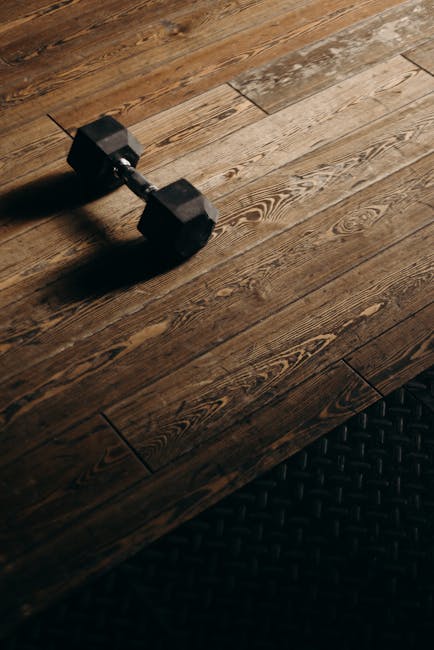Are you experiencing inner elbow pain during your weight lifting sessions? Is it making you want to throw in the towel and never lift again? Before you do that, let’s dive into the root of this pesky pain and uncover the conspiracy behind it – because let’s be real, your inner elbow is probably just plotting against you. So, grab some ice, put on your detective hat, and let’s solve this mysterious case of the inner elbow pain.
Contents
- 1 1. Understanding Inner Elbow Pain: A Common Concern for Weight Lifters
- 2 2. Examining the Anatomy of the Elbow Joint and its Role in Weight Lifting
- 3 3. Common Causes of Inner Elbow Pain in Weight Lifting: Overuse, Injuries, and Technique Errors
- 4 4. Prevention and Treatment Strategies for Inner Elbow Pain in Weight Lifting
- 5 5. Seeking Medical Attention for Chronic or Severe Inner Elbow Pain during Weight Lifting
- 6 Wrapping Up: Hasta La Vista, Inner Elbow Pain!
1. Understanding Inner Elbow Pain: A Common Concern for Weight Lifters
So, you’ve been pumping iron for weeks now, trying to get those chiseled biceps the size of a watermelon but suddenly you feel a sharp pain in your inner elbow. Panic sets in, you start to wonder if it’s just soreness or something more serious. Ladies and gentlemen, let me introduce you to the infamous inner elbow pain.
The medical term for this type of pain is medial epicondylitis, but let’s just call it what it is, a “gym injury”. This condition affects mostly weightlifters (sorry, not sorry) and is caused by the overuse of certain muscles that attach to the inner elbow.
Before you start freaking out about needing surgery to fix this issue, there are a few things you can do to alleviate the pain. First, ease up on the weight. I know, I know, you want those gains, but sometimes it’s better to take one step back to take two steps forward. Second, ice the area and use anti-inflammatory medication to reduce swelling. And lastly, stretch your forearms before and after each workout to help prevent further damage.
- Ice the affected area for 15-20 minutes at a time, 3-4 times per day
- Take over-the-counter anti-inflammatory medication like ibuprofen
- Use a tennis elbow brace to support the area during exercise
- Stretch your forearms by extending your arm and pulling your fingers back towards your wrist
So there you have it, folks. Inner elbow pain may be a common concern for weightlifters, but don’t let it slow you down. Take care of your body and give it the rest and care it needs, and you’ll be back to lifting heavy weights in no time. Just don’t forget the stretching, we don’t need any more “gym injuries” in this world.

2. Examining the Anatomy of the Elbow Joint and its Role in Weight Lifting
Now, let’s get elbow deep in the anatomy of the elbow joint. First off, we’ve got the three major bones. The humerus, radius, and ulna. They sound like the names of three guys who run an auto shop, don’t they? The humerus is the bone in your upper arm, while the radius and ulna are in your forearm, that’s right, the part of your arm that always seems to be in the way when you’re trying to eat soup.
But wait, there’s more! There are also ligaments and tendons in this joint. These are the connective tissues that hold the bones together and attach the muscles to the bones. Kind of like the duct tape that holds my car together and attaches my bumper to the car body.
So, what’s the elbow joint’s role in weight-lifting you may ask? Well, it’s kind of important to those curls you’re doing in the gym. The elbow joint is responsible for flexion and extension of the arm, which is key to bicep and tricep workouts. And let’s not forget about the ever-important forearm exercises like wrist curls, which wouldn’t be possible without the elbow joint. Think of it like a power couple, except instead of taking over the world they’re lifting heavy things.
3. Common Causes of Inner Elbow Pain in Weight Lifting: Overuse, Injuries, and Technique Errors
- Overuse: When it comes to lifting weights, less is often more. Overdoing it can lead to inflammation and pain in your inner elbow. It’s like eating too many Oreos; they taste great at first, but eventually you’re left with regret. To avoid overuse injuries, try limiting the amount of weight you lift, or vary your routine to give your muscles a break.
- Injuries: Accidents happen, even in weightlifting. Maybe you dropped a weight on your elbow, or you knocked it on the corner of a machine. Either way, injuries can definitely cause inner elbow pain. It’s like driving without a seatbelt; you’re just asking for trouble. To avoid injuries, make sure to use proper form and technique, and be aware of your surroundings in the gym.
- Technique Errors: Speaking of technique, it’s important to do things right in the weight room. If you’re not using proper form, it can put unnecessary stress on your muscles and joints, leading to pain and discomfort. It’s like trying to build a house without a blueprint; things might look okay at first, but eventually they’ll fall apart. To improve your technique, consider working with a personal trainer or doing some research online to learn the correct way to perform each exercise.
So there you have it, folks. The three most common causes of inner elbow pain in weight lifting. Remember to take it easy, be aware of your surroundings, and use proper form and technique. And if all else fails, just tell your workout partner that you’re injured so they can carry all the heavy weights for you. Hey, a little humor never hurt anyone, right?
4. Prevention and Treatment Strategies for Inner Elbow Pain in Weight Lifting
People often view inner elbow pain as a rite of passage for weightlifters. However, suffering from pain while executing basic lifts is no fun. To make your weightlifting journey less painful and more enjoyable, here are some prevention and treatment strategies that you can try out.
Prevention
- Work on your form: Incorrect technique can cause elbow pain. If you are unsure about your form, consider hiring a coach or taking classes.
- Warm-up: Warming up before lifting weights loosens your muscles and gets your blood flowing. Do not skip the warm-up.
- Gradually increase the weight: Do not try to lift weights that are too heavy for you. Gradually increase the weight instead of jumping to the highest weight you can manage.
Treatment
- Rest: Stop lifting weights and let your elbow rest. If the pain persists, seek medical attention.
- Ice therapy: Wrap a pack of ice on the injured elbow for 15 to 20 minutes every few hours. Make sure to place a cloth between the ice pack and your skin to avoid frostbite.
- Physical therapy: Consult a physical therapist for a customized treatment and an exercise routine that can strengthen your muscles and prevent future injuries.
By following these simple prevention and treatment strategies, you can recover from and prevent elbow pain, and continue your weight lifting journey without any hindrance. Happy lifting!
5. Seeking Medical Attention for Chronic or Severe Inner Elbow Pain during Weight Lifting
So you’re feeling a sharp pain in your inner elbow, huh? Well, let me tell you, it’s not just your bicep crying for attention. If you’re experiencing chronic or severe inner elbow pain during weight lifting, it’s likely you’re dealing with the infamous “golfer’s elbow.” And no, it doesn’t mean you have to give up golf (unless you’re really bad at it, in which case, you probably should).
But fear not, my fellow gym enthusiast. Seeking medical attention is the way to go. Don’t be afraid to admit that your body needs a little TLC. And trust me, it’s better to rehabilitate now before you’re forced to switch to a different workout regime, like underwater basket weaving. So, here are some tips when seeking medical attention for your inner elbow pain:
– Find a qualified medical professional who understands sports injuries. Sure, your aunt’s sister’s cousin’s daughter may have gotten her nursing degree online, but that doesn’t mean she knows how to get you back to lifting PRs.
– Be honest about your workout routine. It’s not the time to be modest about your 10 sets of 50 reps of bicep curls. Your medical professional needs to understand what movements could be causing the pain.
– Follow the prescribed rehabilitation plan. This may include stretches, physical therapy, and even changing up your weight lifting routine. Don’t slack off on the rehab and be back to square one. Plus, think of all the extra time you’ll have to work on your underwater basket weaving.
So, there you have it, folks. Golfer’s elbow may be a pain in the, well, elbow, but seeking medical attention and following a rehabilitation plan can get you back to the gym in no time. And, hey, maybe even improve your swing on the golf course.
Wrapping Up: Hasta La Vista, Inner Elbow Pain!
And with that, we have finally uncovered the elusive culprit behind that pesky inner elbow pain that has been bothering all you weightlifters out there. But fear not, my muscular friends, for armed with this newfound knowledge, you can now take appropriate measures to bid adieu to the pain once and for all.
So, whether it’s correcting your form, strengthening your forearm muscles, or simply indulging in some good old-fashioned R&R, there’s no excuse for letting inner elbow pain ruin your lifting game anymore. Just remember to listen to your body, take it slow, and of course, keep on lifting!
Until next time, lift heavy, lift smart, and may your gains be ever in your favor. Hasta la vista, inner elbow pain!








Leave A Comment